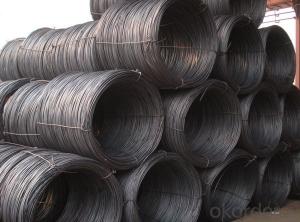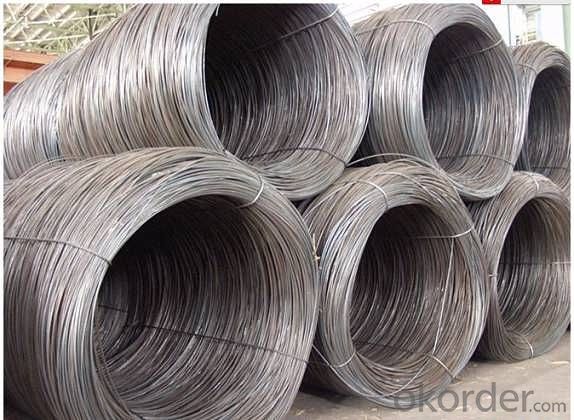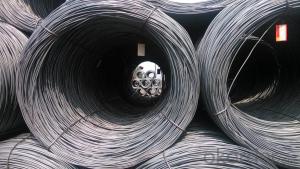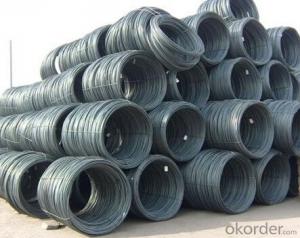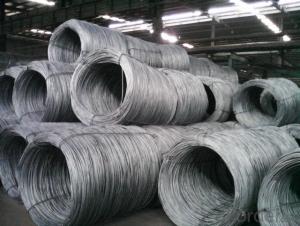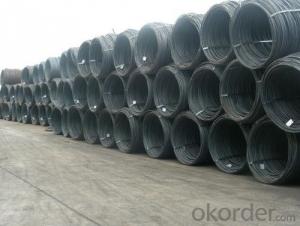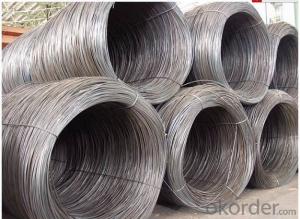Wire rod hot rolled 5.5mm-14mm SAE1006-1018B
- Loading Port:
- Tianjin
- Payment Terms:
- TT OR LC
- Min Order Qty:
- 25 m.t.
- Supply Capability:
- 10000000 m.t./month
OKorder Service Pledge
OKorder Financial Service
You Might Also Like
WIRE ROD Details:
| Minimum Order Quantity: | m.t. | Unit: | m.t. | Loading Port: | |
| Supply Ability: | m.t./month | Payment Terms: | TT OR LC |
Product Description:
Steel Grade: Q195 Standard: ASTM, GB
Diameter: 5.5mm, 6.5mm, 7mm,8mm,9mm,10mm,12mm,14mm
6.5mm can be drawing into 2mm/8.0mm can be drawing into 3mm
Type: Drawn Wire in Coil, each coil weight about 2MT
Brand Name: N-RIVER Place of Origin: Hebei, China
Chemical Composition:
Please kindly find our chemistry of our material based on Q195 as below for your information
Trademark | Rank | Chemical composition (quality score) % | |||||
C | Si | Mn | S | P | |||
| ≤ |
| ≤ | ≤ | |||
Q195 |
| 0.06-0.12 | 0.30 | 0.25 | 0.050 | 0.045 | |
Trademark | Rank | Pulling Test | |||||
Bend PointΔs/Mpa | Tensile Strength | Elongation Ratioδ5% | |||||
Thickness (Diameter) /MM | Thickness (Diameter) /MM | ||||||
≤16 | 16-40 | ≤16 | 16-40 | ||||
≥ | ≥ | ||||||
Q195 |
| 195 | 185 | 315-390 | 33 | 32 | |
Usage and Applications of Wire Rod Q195:
After hot-rolled the products shaped into coil and delivery as finished product, including round, square, rectangular, hexagonal and so on. Since most of the products are round, it is generally called wire rod. Carbon steel wire rod is widely used in construction and manufacturing. Carbon steel wire rod is mainly used for reinforcement of reinforced concrete and welded structure or reprocessed (roberts , nail, etc.) materials, especially used to produce wire drawing, welding electrode, nails, spring, electronic, precise machinery parts and so on
- Q: Can steel wire rod be used for welding applications?
- Indeed, welding applications can incorporate steel wire rod. As a filler material, steel wire rods are frequently employed in welding procedures. Generally composed of low carbon steel, they come in diverse sizes and grades to cater to distinct welding necessities. Steel wire rods can be put to use in various welding applications, including arc welding, MIG welding, TIG welding, and spot welding. When utilized correctly, they yield a sturdy and dependable weld. Nonetheless, it is crucial to meticulously choose the suitable wire rod, taking into account the metal type being welded and the specific welding technique employed.
- Q: What are the different types of steel wire rod surface defect classification and grading systems?
- There are several different types of steel wire rod surface defect classification and grading systems, including the ASTM A510/A510M system and the EN 10221 system. These systems classify and grade surface defects based on their type, size, and severity, providing guidelines for quality control and acceptance criteria in the steel wire industry.
- Q: How is steel wire rod coated to prevent corrosion?
- Steel wire rod can be coated in several ways to prevent corrosion. One common method is galvanization, which involves dipping the wire rod into a bath of molten zinc. The zinc coating provides a protective layer that acts as a barrier between the steel and the corrosive elements in the environment. Another method is through the application of various types of polymer coatings. These coatings can be sprayed, dipped, or electrostatically applied onto the wire rod. The polymer coating creates a barrier that prevents moisture and other corrosive substances from reaching the steel surface. Additionally, some wire rods can be coated with a combination of zinc and polymer coatings for enhanced protection against corrosion. The specific coating method used depends on factors such as the intended application of the wire rod and the level of corrosion resistance required.
- Q: How are steel wire rods used in the production of screws and bolts for mechanical assemblies?
- Steel wire rods are used in the production of screws and bolts for mechanical assemblies as the primary raw material. These rods are first drawn into wire of the desired diameter, which is then cut into specific lengths to form the screw or bolt. The wire rods provide the necessary strength and durability required for mechanical applications, ensuring that the screws and bolts can withstand heavy loads and provide reliable fastening in various assemblies.
- Q: What are the different weldability testing methods for steel wire rod?
- There are several different weldability testing methods for steel wire rod. These include the macroscopic examination, which involves visually inspecting the weld for any defects or anomalies; the bend test, where the weld is bent to evaluate its ductility and resistance to cracking; the tensile test, which measures the strength and elongation of the weld; the hardness test, which determines the hardness of the weld and its susceptibility to cracking; and the impact test, which assesses the weld's ability to withstand sudden loads and impacts.
- Q: How is steel wire rod manufactured?
- Steel wire rod is manufactured through a process called hot rolling, where a billet of steel is heated and passed through a series of rolling mills to reduce its diameter and increase its length. This process helps to improve the mechanical properties of the steel, making it more ductile and suitable for various applications, such as manufacturing wire products or reinforcing materials.
- Q: What are the main components of a steel wire rod mill?
- The main components of a steel wire rod mill include the furnace, continuous casting machine, rolling mill, cooling bed, and coiling machine.
- Q: What are the different types of steel wire rod annealing atmospheres?
- Depending on the desired outcome and specific requirements of the process, there are various types of annealing atmospheres for steel wire rods. These atmospheres differ in terms of the gases used and the conditions maintained during annealing. 1. Nitrogen Atmosphere: Steel wire rod annealing processes commonly utilize nitrogen gas. This inert gas protects the material from oxidation and decarburization. It creates a stable environment for consistent and controlled heat treatment. 2. Hydrogen Atmosphere: Another frequently used annealing atmosphere for steel wire rods is hydrogen gas. Hydrogen helps minimize surface oxidation and can remove surface contaminants or impurities, resulting in a clean and bright surface finish. 3. Vacuum Atmosphere: Vacuum annealing involves creating a low-pressure environment by removing air and other gases from the annealing chamber. This atmosphere prevents oxidation and provides precise control over the annealing process. Vacuum annealing is ideal for high-quality wire rods with minimal surface defects and improved mechanical properties. 4. Inert Gas Mixtures: In certain cases, a combination of inert gases like nitrogen and hydrogen may be used as an annealing atmosphere. This mixture offers the advantages of both gases, including protection against oxidation and impurity removal. The specific mixture and ratios depend on the desired outcome and material requirements. 5. Controlled Atmosphere Furnaces: Controlled atmosphere furnaces enable precise regulation of the annealing atmosphere by continuously monitoring and adjusting the gas composition. This allows for the optimization of annealing conditions to achieve desired material properties and surface finishes. It is important to consider the specific steel composition, desired properties, and end-use application of the wire rod when selecting the annealing atmosphere. By carefully choosing the appropriate atmosphere, steel wire rods can undergo a controlled heat treatment process that enhances their mechanical properties, surface quality, and overall performance.
- Q: How are steel wire rods used in the manufacturing of welding wires for joining metals?
- Steel wire rods are used in the manufacturing of welding wires for joining metals by being drawn down to the desired size and coated with a flux material. This process ensures that the welding wire has the necessary strength and durability to effectively join metals together during the welding process.
- Q: How is steel wire rod used in the manufacturing of wire mesh for concrete reinforcement?
- Steel wire rod is used in the manufacturing of wire mesh for concrete reinforcement by being formed into a grid-like pattern. This wire mesh is then embedded within the concrete to provide added strength and stability, preventing cracking and ensuring durability. The steel wire rod acts as a reinforcement, distributing the load and increasing the overall structural integrity of the concrete.
Send your message to us
Wire rod hot rolled 5.5mm-14mm SAE1006-1018B
- Loading Port:
- Tianjin
- Payment Terms:
- TT OR LC
- Min Order Qty:
- 25 m.t.
- Supply Capability:
- 10000000 m.t./month
OKorder Service Pledge
OKorder Financial Service
Similar products
Hot products
Hot Searches
Related keywords
